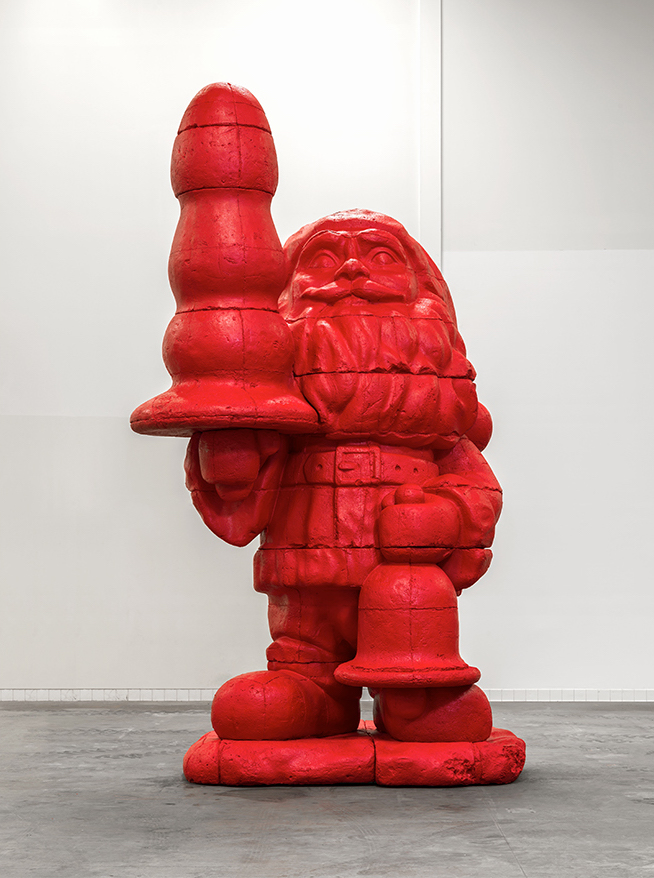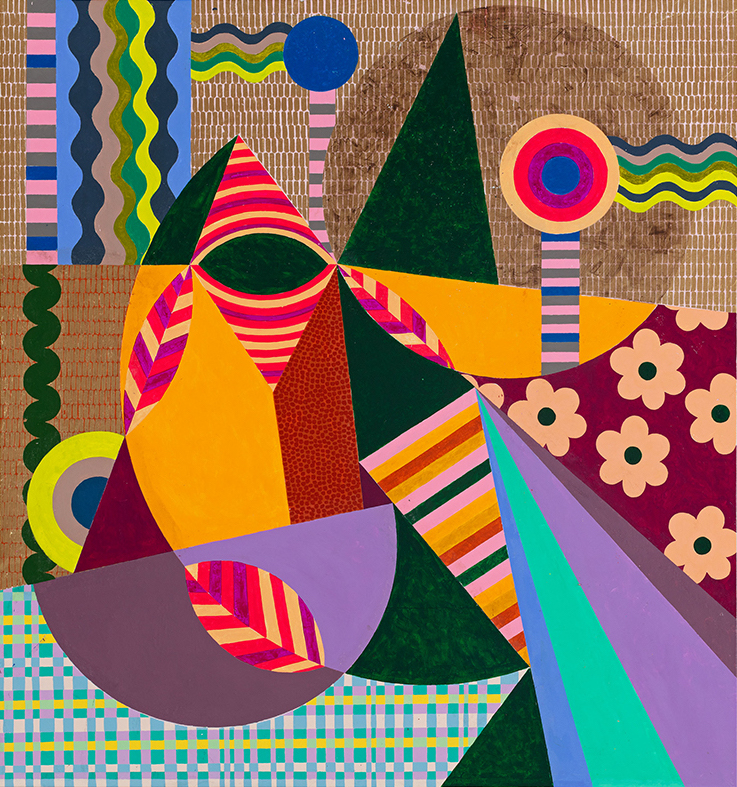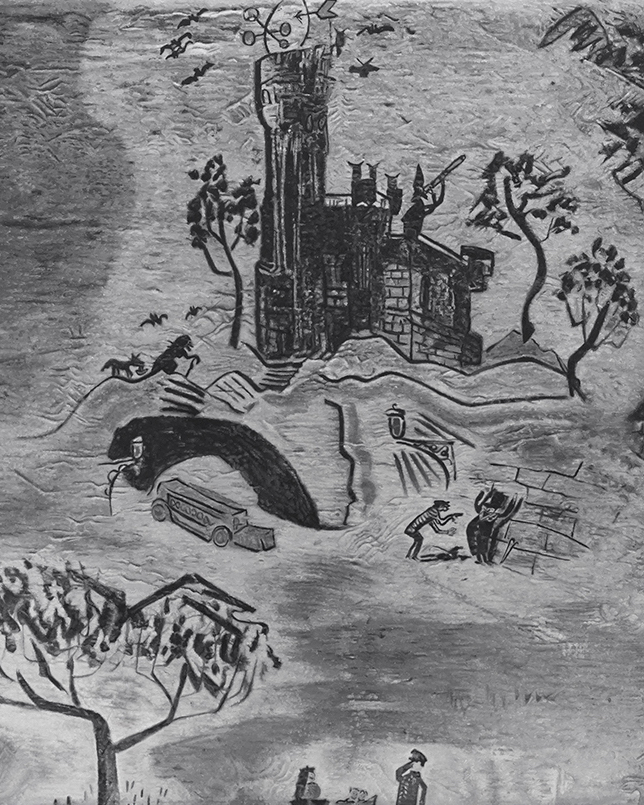Paul McCarthy
Them as Was Is
Gallery Openings—15 Sep 2023, 6 to 9 PM
Potsdamer Straße

Paul McCarthy, Santa with Butt Plug, 2009–2012, Paul McCarthy, Santa with Butt Plug, 2009–2012, steel, © Paul McCarthy, Courtesy the artist and Hauser & Wirth, Photo: Fredrik Nilsen © Paul McCarthy, Courtesy the artist and Hauser & Wirth, Photo: Fredrik Nilsen
Bringing together past and present, then and now, Them As Was Is presents two fundamental aspects of McCarthy’s practice. On the ground floor, eighteen sculptures constitute an early endeavour by the artist to combine different periods of sculpture into one, allowing visitors to draw out the similarities that weave together his most iconic sculptural projects. On the gallery’s upper floor, a series of drawings and video works from the artist’s more recent A&E (2019–) project show film and performance to be at the heart of McCarthy’s practice.
At once playful and uncanny, the Colored Carbon Fiber Group (CCFG), 2004–2012, revisits many of the motifs for which McCarthy is most known. Two sculptures depict Michael Jackson with enlarged head and feet, distorting the King of Pop while simultaneously paying homage to Jeff Koons’ Michael Jackson and Bubbles of 1988. Eight ‘Pirate Heads’ complicate the historical bust, and point to the pirate’s dual symbolism as an articulation of heteronormative masculinity and of wanton greed. The grouping is overseen by two monumental sculptures which measure over six metres in height. Henry Moore Bound to Fail, 2010–2013, relates to numerous existing variations of the same sculpture, including a smaller version in free-form plaster made by the artist in 1960, and a large inflatable created for the roof of New York’s Whitney Museum in 2004. Santa with Butt Plug, 2009– 2012, perhaps one of the artist’s most recognisable motifs, compounds a symbol of childhood fantasy with one of debauchery and desire. Our fundamental impulses, McCarthy here suggests, collide with our most cherished and fictitious cultural myths.
The gallery’s second floor presents drawings created by McCarthy during improvised performances between himself and German actress Lilith Stangenberg as part of their ongoing A&E project. The project’s title refers to the layered alter egos which McCarthy and Stangenberg assume: Adolf Hitler & Eva Braun, Adam & Eve, Arts & Entertainment, America & Europe. Created during hours-long sessions in which the collaborators enter a state of delirium, the drawings possess a radical immediacy and undeniable physicality. Alongside unconscious scrawls, magazine clippings, and imagery of Hitler and Mickey Mouse, certain drawings incorporate the artist’s tools, providing witness to the gestures embedded in them.
Three video works further elucidate McCarthy’s A&E project. One, titled A&E, Yellow Monkey (FUCKUR), 2022, chronicles a drawing session at McCarthy’s Santa Anita studio, while A&E, Adolf and Eva, Dead End Hole (Picnic), 2021/2023, and A&E, Adolf and Eva, Cooking Show, 2022/2023, present two recent performances—the former taking place in the basement of the KODE Art Museum in Bergen in late 2021, and the latter at a property in California in 2022.
In A&E, Adolf and Eva, Cooking Show, a quasi-comical reenactment of the ritual of cooking quickly descends into a sinister scene of domestic violence, as McCarthy’s drunken buffoon Adolf Hitler and Stangenberg’s Eva Braun, dressed as Marilyn Monroe, torment each other in a depiction of reciprocal love-hate and violence. As the film increases in brutality, so do the characters’ muddled identities: McCarthy is an American acting as a German, Stangenberg a German dressed as an American. There is no stability, no redemption, only the catharsis of unrestrained violence and the compulsive stammering of insults—Eva repeatedly calls Adolf an ‘American capitalist pig’, while he calls her a ‘German whore’. Shifting back and forth between male and female, public and private, attraction and repulsion, McCarthy’s films are existentialist theatre, holding up a mirror to the conventions and fallacies of Western culture.
Paul McCarthy (*1945, Salt Lake City) lives and works in Los Angeles. McCarthy’s work has been the subject of solo exhibitions in international institutions including KODE Art Museum, Bergen (2021); Hammer Museum, Los Angeles (2020 and 2011); Zabludowicz Collection, London (2018); Fundació Gaspar, Barcelona (2017); Lokremise, St. Gallen; Henry Art Gallery, University of Washington, Seattle (both 2016); Nasher Museum of Art, Duke University, Durham; The Renaissance Society, Chicago; Volksbühne, Berlin; Schinkel Pavillon, Berlin (all 2015); Monnaie de Paris; Space Studios, London (both 2014); Park Avenue Armory, New York (2013); Neue Nationalgalerie, Berlin (2012); Kunsthalle Wien, Vienna (2011); Fondazione Nicola Trussardi, Milan (2010); Salt Lake Art Center (2009); Whitney Museum of American Art, New York (2008); Whitechapel Gallery, London (2005); Centro de Arte Contemporáneo, Malaga (2004); Tate, London, The National Museum of Contemporary Art, Oslo (both 2003); New Museum of Contemporary Art, New York (2001); The Museum of Contemporary Art, Los Angeles; and Secession, Vienna (both 2000), among many others.
Works by Paul McCarthy are in the collections of Carnegie Museum of Art, Pittsburg; Fondazione Sandretto Re Rebaudengo, Turin; Hiroshima City Museum of Contemporary Art; Kunsthaus Zürich; Kunstsammlung NRW, Düsseldorf; MONA – Museum of Old and New Art, Hobart; mumok, Vienna; Museum Boijmans Van Beuingen, Rotterdam; MOCA – The Museum of Contemporary Art, Los Angeles; Museum of Fine Arts, Boston; The Museum of Modern Art, New York; National Museum of Contemporary Art, Athens; Solomon R. Guggenheim Museum, New York; Tate, London; Utah Museum of Fine Arts, Salt Lake City; Walker Art Center, Minneapolis; and Whitney Museum of American Art, New York, among others.
Beatriz Milhazes
Paisagem em Desfile
Gallery Openings—15 Sep 2023, 6 to 9 PM
Artist Talk—14 Sep 2023, 3 PM
Goethestraße
Internationally renowned for her large-scale, vibrant and highly colourful paintings, Milhazes presents a new body of work in her own form of abstraction, self-termed ‘chromatic free geometry’. These were made over the last two years, using her meticulous and complex process of ‘monotransfer’, first developed in 1989. This very controlled method of image-transfer is based on experiments with acrylic paint and monotype printing. By painting motifs onto plastic sheets before carefully transferring them onto canvas, Milhazes imbues her work with a sense of vitality. The artist has referenced Henri Matisse’s collages as related to her own technique of layering, creating the appearance of a glossy, highly finished surface, disrupted by small chips and fissures.
Additionally to the works on canvas, the exhibition presents a new wall painting executed entirely in grey tones, for the first time in the artist’s oeuvre.

Beatriz Milhazes, O Vendedor de Frutas (Fruits Street Vendor), 2023, © Beatriz Milhazes Studio, Courtesy the artist and Galerie Max Hetzler, Berlin | Paris | London, Photo: Pepe Schettino
Translating to ‘Landscape on Parade’, the title of the exhibition alludes to the main influences on the artist’s practice over the last few years. Since 2017, Milhazes has returned to more figurative elements, a development which is reflected both in her compositions and titles alike. The diagonals, which she has begun to incorporate within her paintings, take the shape of triangular and pointed constructions, melded with flowing lines. Several of her new works reference childhood memories, and the popular culture of Rio de Janeiro in particular. O Arlequim (The Harlequin), 2021–2022, and O desfile de leques I (Fan parade I), 2023, for example, are evocative of the Carnival spirit, with its vibrant costumes, samba rhythms and lively parades.
Equally present is the familiar theme of nature, which has always played an important role in Milhazes’ work. Drawing inspiration from the ocean, situated near to her studio, as well as the Botanical Gardens and Tijuca rainforest, paintings such as Inteligência das Estrelas (Intelligence of the Stars), 2022, is filled with undulating waves, leaflike organic shapes, flowers and stars, while in A dança da árvore I (The dance of the tree I), 2022, a plant appears to bloom from a patterned background. Such works reveal the artist’s deep connection with nature, her surroundings and the Earth, which have influenced her both artistically and spiritually.
In colour and composition, style and form, Milhazes alludes to Baroque art, the work of the first generation of abstract painters such as Wassily Kandinsky, Piet Mondrian and Alexander Rodchenko, and artists including Sonia Delaunay and Bridget Riley. All of these references are important for their visual kinship as well as for the transcendent and intellectual context they provide. Indeed, meticulously rendered and richly evocative, the transfer technique of Milhazes’ seemingly spontaneous compositions creates an artistic pause, a philosophical moment of consideration and stillness within the brilliant vibrancy of her paintings.
Beatriz Milhazes (*1960, Rio de Janeiro, Brazil) lives and works in Rio de Janeiro. Solo exhibitions of the artist’s work have been held in international institutions including Turner Contemporary, Margate (2023); The Long Museum, Shanghai (2021); MASP – Museu de arte de Sāo Paulo Assis Chateaubriand and Itaú Cultural, Sāo Paulo (2020); The Jewish Museum, New York (2016); Espaço Cultural Unifor, Fortaleza (2015); PAMM – Peréz Art Museum, Miami (2014); Centro Cultural Paço Imperial, Rio de Janeiro (2013); MALBA – Museo de Arte Latinoamericano de Buenos Aires (2012); Fondation Beyeler, Basel (2011); Fondation Cartier pour l’art contemporain, Paris (2009); Pinacoteca Estação, São Paulo (2008); CCBB RJ – Centro Cultural Banco do Brasil, Rio de Janeiro (2003); 21st Century Museum of Contemporary Art, Kanazawa (2005); and Ikon Gallery, Birmingham (2001), among others. Milhazes represented Brazil at the 50th Venice Biennale in 2003 and has been granted several prominent public art commissions across the UK and the USA.
Works by Beatriz Milhazes are part of renowned collections including Centre Pompidou, Paris; Fondation Beyeler, Basel; MASP – Museu de arte de Sāo Paulo Assis Chateaubriand, Sāo Paulo; Museo Nacional Centro de Arte Reina Sofía, Madrid; Museo TB A21, Thyssen Bornemisza Art Contemporary, Vienna; SFMOMA – San Francisco Museum of Modern Art; The Metropolitan Museum of Modern Art, New York; MoMA – The Museum of Modern Art, New York; Solomon R. Guggenheim Museum, New York; Tate, London; and Museum of Contemporary Art Tokyo, among others.
Rudolf Stingel
Richard Prince
Albert Oehlen
Gallery Openings—15 Sep 2023, 6 to 9 PM
Bleibtreustraße
The dictionary definition of a remix in music is as follows: ‘Remix is a new version of a piece of music which has been created by putting together the individual instrumental and vocal parts in a different way.’1 The works in this exhibition all refer recognisably and decidedly to art from the 20th century but differ widely in their intellectual attitudes, variety of techniques, and diverse perspectives which the artists take in riffing off their inspirations.
Albert Oehlen’s admiration for the Kyiv-born American artist John Graham reaches back to the 1990s. Executed nearly four decades later, in 2019, the two large-scale works on view in this exhibition are rendered in charcoal on canvas in different tonalities of grey. Presenting a cartoon-like figure juxtaposed against a vast white ground, the compositions interpret and transform Graham’s painting Tramonto Spaventoso (Terrifying Sunset), 1940–1949.
Throughout his career, Richard Prince has included elements of American popular culture, as well as the icons of modern art history. The artist has described his method as ‘sampling’. Prince makes speculations by setting up complex relationships and creating short-circuits between both image and word. In the two paintings presented in this exhibition, Prince draws on art history by engaging with the work of Pablo Picasso.
Rudolf Stingel takes inspiration from his countryman Ludwig Bemelmans – who, like him, was born in Merano, South Tyrol – and the famous murals which he created for the Carlyle Hotel in New York in 1947. Diverging from their original palette, Stingel’s largely black and white paintings offer photorealistic depictions of individual scenes drawn from Bemelmans’ nostalgic, warmly lit images.

Rudolf Stingel, Untitled (Bemelmans), 2016, © Rudolf Stingel, courtesy the artist
Albert Oehlen (*1954, Krefeld), lives and works in Switzerland. He has been exhibiting regularly at Galerie Max Hetzler since 1981. Oehlen’s work has been the subject of numerous exhibitions in international institutions, including the Sprengel Museum Hannover (duo show with Carroll Dunham); Serpentine Gallery, London (both 2019–2020); Aïshti Foundation, Beirut (2018–2019); Palazzo Grassi, Venice (2018– 2019); Museo Nacional de Bellas Artes, Havana (2017); The Cleveland Museum of Art and Guggenheim, Bilbao (2016); New Museum, New York (2015); Kunsthalle Zürich (2015).
Richard Prince (*1949, Panama Canal Zone) lives and works in Upstate New York. Prince’s work has been the subject of solo exhibitions in international institutions including the Louisiana Museum of Art, Humblebaek (2022); Museum of Contemporary Art Detroit (2019); Espace cultural Louis Vuitton, Beijing; Astrup Fearnley Museet, Oslo (all 2018); Los Angeles County Museum of Art (2017); The artist participated in the Biennale di Venezia in 2003 and 2007, as well as The Whitney Biennial in 1985, 1987, 1997 and 2004.
Rudolf Stingel (*1956, Merano) lives and works in New York. The artist’s work has been the subject of numerous solo exhibitions in international institutions, including Fondation Beyeler, Basel (2019); Palazzo Grassi, Venice (2013); Secession, Vienna (2012); Neue Nationalgalerie, Berlin (2010); Museum of Contemporary Art, Chicago; Whitney Museum of American Art, New York (both 2007); among others.
